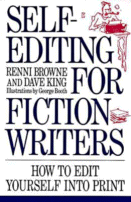
(Thanks inkygirl.com for the comic!)
Hey everyone ;)
 Recently it was suggested we discuss the sort of mistakes an author makes that can lead to a rejection. At the same time, I was in another discussion where I recommended the book: "No More Rejections: 50 Secrets to Writing a Manuscript that Sells" by Alice Orr.
Recently it was suggested we discuss the sort of mistakes an author makes that can lead to a rejection. At the same time, I was in another discussion where I recommended the book: "No More Rejections: 50 Secrets to Writing a Manuscript that Sells" by Alice Orr. While I didn't get read this book until after I was already published, the advice in here is awesome. I put it right up there with Self-Editing for Fiction Writers by Browne and King.
While I didn't get read this book until after I was already published, the advice in here is awesome. I put it right up there with Self-Editing for Fiction Writers by Browne and King.In Orr's book, on page 134, she discusses Crossroads, An Author Self-Interrogation and while so much of what comes before is vital to understand, this is one of my favorite sections. She not only offers us the basics of how to write a great scene, she touches on those aspects that make a scene bad.
From the book:
Ask yourself the following questions in reference both to the specific scene you are writing and to your novel as a whole. Your writerly instincts—again, trust me, you do have them—will tell you what choices you must make to strengthen your scene and your story. Check back through this passage for guidance. But, first of all, listen to those instincts of yours. Once you come to recognize your instinct's cadence and pay attention to its message, it will almost never steer you wrong.
From there, Orr offers 14 points to cover, explaining each one. I'll offer the first line from each one here:
1) What does your main character want in this scene?
2) What is this character willing to do to get what she wants?
3) Answer these first tow questions for each pivotal character in the scene.
4) What stands in the way of your main character's goal in this scene and creates the conflict as the character resists this opposition?
5) Do we know for certain which character's consciousness we are in here?
6) Do we see action and reaction between characters?
7) In dialogue, is there ever a question about which character is speaking?
8) Is what is being said in the dialogue interesting, compelling, riveting, maybe even startling?
9) What is the action of the scene?
10) Does something unepected happen in this scene?
11) Is there subtext beneath what is being said and done on the surface of the scene?
12) Does each character's situation change from the beginning to the end of the scene?
13) What is the outcome of this scene?
14) Have you overwritten the scene?
Of course, as I said, Orr explains in greater detail many of these fourteen points, and then ends with a practical exercise you can do to explore these directly in your own writing. (Which is one of the reasons I really loved the book and recommend it highly to anyone.)
Applying these fourteen points to your scenes, especially your opening scenes, will really help you draw a reader in—and that is exactly what an editor is when he or she opens that email or envelope you've submitted. They are a reader with high expectations. You don't want to let them down by writing melodramatic or purple prose in an attempt to cover up a weakness you haven't strengthened yet. For instance, instead of showing, a new writer will try to use power words to hide their lack of understanding. Such as:
Telling: He felt sad and cried out, weeping.
Telling, with power words: His despair cut through his soul like a knife and tears trickled down his grieving face.
Showing: He covered his face and slumped in the chair, barely able to breathe for the thick grief in his throat. His ragged groan filled the empty room, bouncing back to him as the hot, burning tears finally came and he wept.
Between Orr's points of reference for crafting a scene and learning to show, you have a much stronger chance the editor will read more than the opening paragraphs. Whether or not he or she rejects the work will then depend on what they're looking for, rather than poor writing.
Any questions?
Warmly,
Jenny;)




3 comments:
Self editing for fiction authors is a must have. Jenny recommended the book to me a while back.
I've learned a lot reading it three times total. Unlike any other self-help text book, Self editing for fiction authors, is also a fun book to read. The various sections are easily understood and samples are given throughout.
--Martin
http://myspace.com/benzman01
Awesome post Jenny. I am on my way to go get those two books
Thanks
dawn
So glad y'all found this a helpful blog! I'm always trying hard to give my readers useful information, or at least be entertaining! :)
Thank you so much for stopping by and commenting!
Warmly,
Jenny:)
Post a Comment